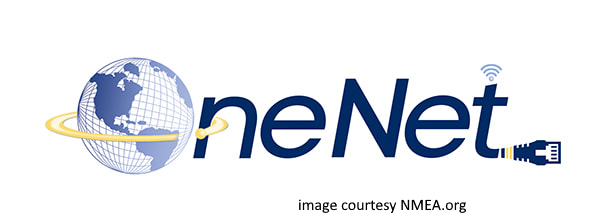OneNet new NMEA Networking technology
will OneNet be the near future for our onboard networks?
Well, I do not know but it certainly looks very promising.In this article I will elaborate a bit on this new technology and also give some intersting and relevant links for further reading.
Introduction

:
will OneNet be the near future for our onboard networks?
Well, I do not know but it certainly looks very promising. In this article I will elaborate a bit on this new technology and also give some intersting and relevant links for further reading.
The National Marine Electronics Association (NMEA) has been at the forefront of developing communication standards for the marine industry. With the recent advancements in technology, the NMEA has introduced the OneNet and Ethernet networking standard to enhance communication and data exchange capabilities onboard yachts and other marine vessels. This document aims to explain the functionality of NMEA OneNet and Ethernet networking and how it enhances on board functionality on yachts.
1.OneNet and Ethernet Networking?
NMEA OneNet is a standardized communication protocol designed to enable seamless data exchange between different marine electronics and systems on a yacht using Ethernet networking. It builds upon the existing NMEA 2000 standard, which uses Controller Area Network (CAN) bus technology, and introduces the use of Ethernet for higher bandwidth and flexibility.
2.Benefits of OneNet and Ethernet Networking:
NMEA OneNet and Ethernet networking offer several advantages for yacht owners, crew, and passengers:
a. Higher Bandwidth: One of the primary benefits of Ethernet networking is its ability to provide higher data transfer rates compared to NMEA 2000 CAN bus. This increased bandwidth allows for faster and more efficient exchange of data, particularly for high-definition video, radar, and other data-intensive applications.
b. Simplified Wiring: Ethernet networking significantly reduces the complexity of wiring systems onboard. With a single Ethernet cable, multiple devices can communicate and share data, eliminating the need for separate cables for each device. This simplification reduces installation time and costs.
c. Scalability: OneNet and Ethernet networking provide greater scalability, allowing yacht owners to easily integrate new devices and systems into their existing networks without requiring major overhauls. This scalability ensures that yachts can stay up-to-date with the latest technology without significant disruption.
d. Interoperability: The standardized nature of NMEA OneNet ensures that devices from different manufacturers can seamlessly communicate with each other, promoting interoperability. This open architecture allows yacht owners to choose from a wide range of compatible marine electronics.
e. Enhanced Integration: Ethernet networking facilitates the integration of diverse systems, such as navigation, communication, entertainment, security, and control systems, into a unified network. This integration enhances overall system performance and simplifies operation for the crew.
3.Key Components and Features:
To implement NMEA OneNet and Ethernet networking on a yacht, several key components and features are involved:
a. OneNet Gateway: The OneNet Gateway serves as the bridge between existing NMEA 2000 devices and the new Ethernet-based devices. It facilitates the seamless transfer of data between the two networks, ensuring compatibility and smooth communication.
b. Ethernet Switches: Ethernet switches are used to create the onboard network backbone, connecting various devices and systems. They offer multiple Ethernet ports to accommodate multiple devices, such as chartplotters, radars, cameras, and more.
c. Ethernet-enabled Devices: With the adoption of Ethernet networking, new marine electronics and systems are designed to have built-in Ethernet connectivity. These devices can communicate directly over the Ethernet network, allowing for efficient data exchange.
d. NMEA OneNet Protocols: NMEA OneNet utilizes various protocols for data communication, including TCP/IP (Transmission Control Protocol/Internet Protocol) and HTTP (Hypertext Transfer Protocol). These protocols ensure reliable and secure data transfer across the network.
4.Implementation Considerations:
When implementing NMEA OneNet and Ethernet networking on a yacht, certain considerations must be taken into account:
a. System Design: Proper planning and system design are essential to ensure that the network meets the specific requirements of the yacht. Factors like the number and types of devices, cable routing, and network redundancy should be carefully considered.
b. Device Compatibility: Ensure that all new devices integrated into the network are NMEA OneNet and Ethernet-enabled. Additionally, check for compatibility with existing NMEA 2000 devices when using a OneNet Gateway.
c. Network Security: As with any network, onboard network security is crucial to protect against potential cyber threats. Implement robust security measures such as firewalls, access controls, and regular software updates to safeguard the network.
d. Training and Support: Crew members should receive adequate training on the new network and devices to maximize its benefits. Additionally, ensure access to technical support and resources for troubleshooting and maintenance.
Conclusion
NMEA OneNet and Ethernet networking bring a new level of functionality and efficiency to yachts by enabling high-speed data exchange, simplified wiring, and enhanced integration of marine electronics and systems. The standardized approach ensures compatibility and interoperability, making it easier for yacht owners to stay at the cutting edge of marine technology. By carefully considering implementation and security aspects, yacht owners can fully leverage the advantages of OneNet and Ethernet networking for an enhanced onboard experience.
Further Reading:
OneNet, NMEA finally creates a marine Ethernet standard! – Panbo
Leave a comment